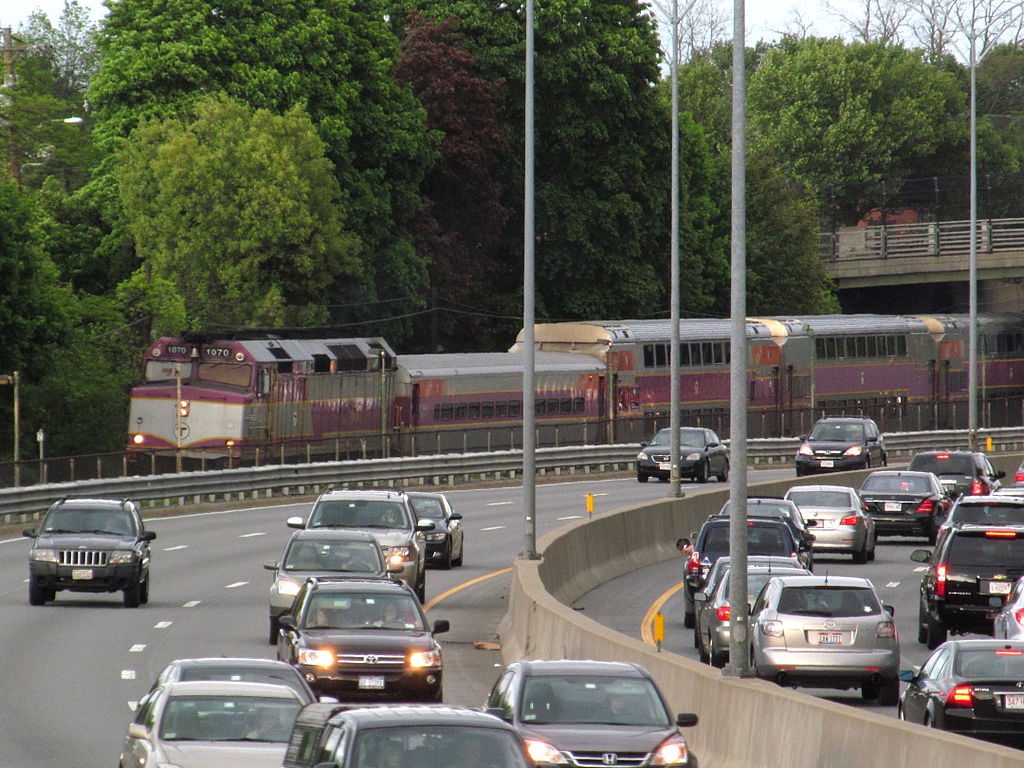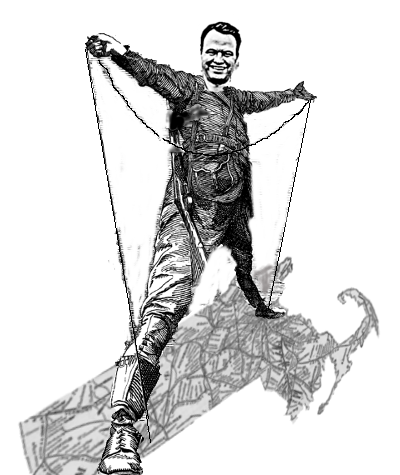Editorial: A Studied Approach (and Rail) Essential for the Valley…
UPDATED 9:04PM: The Massachusetts Senate adopted Sen. Lesser’s amendment. The rail study will go to the House-Senate conference committee.

The Worcester line along the Mass Turnpike in Newton. Sen. Eric Lesser’s rail study could lead to improvements across the commonwealth’s spine. (via wikipedia)
State Senator Eric Lesser’s East-West rail study appeared ready to leave the station last year. It survived House-Senate negotiations and passed both chambers. But then, in one of several vetoes, Governor Charlie Baker smothered it, ostensibly on the advice of Springfield bus mogul Peter Picknelly. The study was not among the items the legislature chose to override before the session ended on July 31.
Lesser has refiled his amendment this year. The Senate is debating amendments to its budget now. While this blog was reasonably confident the upper house would adopt it once more, the study is a long way from passage. But it must pass. The process it will hopefully kick off is, in this blog’s view, essential to truly reviving this region.
As written, Lesser’s legislation would commission the Massachusetts Department of Transportation to look at the technical and engineering considerations of regular service between Springfield and Boston. Most imagine several trips a day, timed for commuters. But to make travel times reasonable, both the state-owned line to Worcester (where commuter service now ends) and the CSX-owned tracks to Springfield will need hefty upgrades.

It would be a lifeline, really, or at least a jolt for the 413. (created via wikipedia & Lesser campaign images)
Environmental law and planning processes demand this kind of comprehensive report to pursue funds to upgrade infrastructure and establish useful rail service, thereby linking East and West.
Lesser often speaks of such service as a “game changer.” We go further. It is an imperative.
We do not discount the economic development that is happening, including right here in our own City of Springfield. There is tremendous potential of the CRRC railcar plant and Union Station even without East-West rail in the short-term. As dubious as we are—and always have been—about MGM, it will almost certainly contribute to the city and region’s economy. Elsewhere, investment continues in smaller manufacturers in other Hampden County cities and down.
But these are not and will not be enough. Outside of a few pockets of the region, storefronts remain empty. Longstanding eateries have closed. Job prospects are minimal, prompting a brain drain as better educated workers move on. A new emphasis on tech and the arts is years away from replacing thousands of jobs lost over the decades and amid the current retail slump. Connecticut seems set to open a third casino undercutting MGM, but tourism is anyway hardly enough to revive.
This rail link, if reasonably and expediently executed, could arrest the grimmest forecasts. It could provide much cheaper housing, relieving the pressure in metro Boston and bring jobs and wealth West. As we have said many times before, it could also do much to bridge this dastardly chasm between East and West in one of the nation’s smallest states.

Amtrak’s westbound Lake Short Limited, currently the only rail connection between Springfield and its state capital. Upgrades would prompt better service around, to and from Boston. (via wikipedia)
But this project is not merely for the West. A fuller revamp of the old Boston & Albany line would benefit all communities along the line.
On Saturday, your editor-in-chief had occasion to visit Newton. Even on a weekend, traffic was clogging what observant Turnpike jockeys know is the 1960’s extension running through Newton Corner. Rush hour is immeasurably worse. Admittedly, the city streets were okay, but imagine how much better it would be if rail were an option not just to get to from Springfield or Worcester to Boston, but to get around the communities along the line as well.
A business group in Boston recently registered its support as well.
Choking on traffic may suppress a region’s potential, but, the environment aside, it won’t kill it. The situation is, in our view, much more dire for the 413. Economic inequality is rife in Massachusetts both within its booming cities and by region. But Western Mass—as well as other Bay State regions—looks more and more like wilting Midwest Rust Belt communities even as Greater Boston blooms
Simply not enough economic development exists now to halt, let alone reverse area decline and restore some luster and pride to this region. Hopefully, indeed frustratingly, this fate is not inevitable. Unlike many Rust Belt cities and towns, we are well within reasonable distance of a major economic engine.
A long journey begins with a single step. Right now, that is ordering this rail study. Lesser has drafted a standalone bill too, but its best hope is inclusion in the budget.
The Senate has passed it and the House should concur. The governor would do this region a service to allow the study this time and not succumb to the narrow interests and paranoia—there’s no reason to assume Peter Pan Bus Lines would suffer—of one businessman. If not, the legislature must override.
The alternative is too mediocre to restore Western Massachusetts.